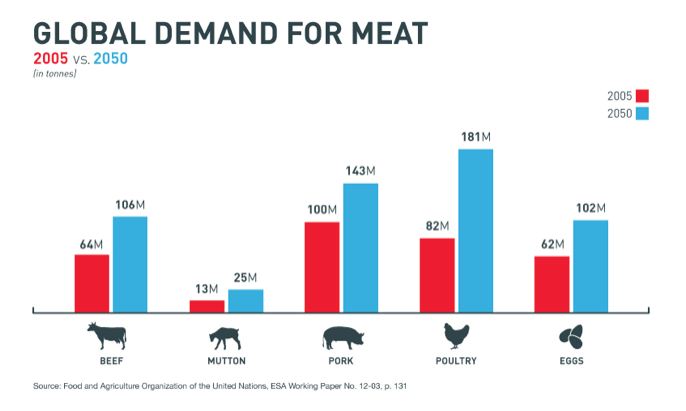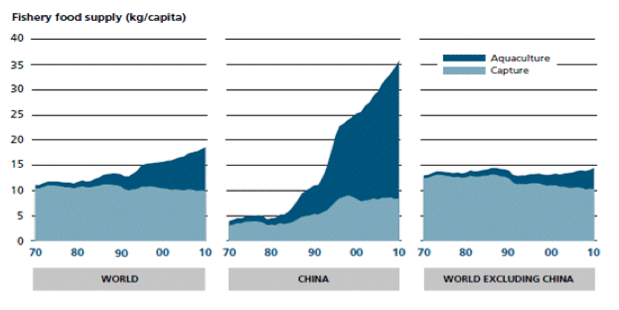Tech is becoming a part of all aspects of life and sustainability is no exception to this. In this piece, in the run-up to our Beyond Business As Usual Forum, we present the future of food in China and how tech can be leveraged to help provide for a growing, more expectant urban population.

Over the past 30 years, China has experienced rapid levels of urbanization and increased individual affluence. But as these developments have occurred, arable land depletion and structural inefficiencies in the food value chain have made providing safe, accessible, and affordable food to the market difficult.
It is a system that has seen numerous safety failures, where consumers are being asked to pay more, and in recent years has resulted in many of China’s leading food firms investing overseas. All actions, and reactions, to a system that has been asked to grow too fast, and given the size and scalability required in China as another 300 million people enter the urban environment, for China’s food systems to be designed to deliver accessible, safe, and affordable foods, it is going to take a spectrum of solution. Be it through helping farmers be more productive, to increase the efficiency of the consolidation and distribution process, or to help empower consumers to make better decisions about the foods they are purchasing.
One way to achieve this is through technological innovation. Through the efforts and collaboration of various stakeholders, we are beginning to see a new era of technological evolution creating impact, providing answers to the challenges that have previously seemed too difficult or expensive to overcome.
Here, we outline 4 technologies where a market and opportunity exists for domestic solutions in China’s food & agriculture industry. An industry that has already grown beyond its limits and is having to look beyond its borders to sustainably feed its people.
Direct to Consumer Food Retail Services
China has prospered into the largest online grocery market in the world. By 2020, it is expected to be worth 180 billion dollars. Companies have begun to invest in the new trend and funding is growing within the market. Online shopping creates unprecedented consumer choice as products from around the country and the world can be easily accessed. Access to fresh organic food has become easy for people living in cities. FIELDS and SH Organics are companies providing these services for Chinese consumers, promoting a more sustainable method of accessing food.
The online grocery market is helping remove the middleman in food distribution, increasing transparency. Consumers feel confident in what they are buying and can trust that the food is coming directly from where they order it. Not only farms but also large food retail companies throughout China have invested in online shopping and the growth of the industry signifies a market of success and future opportunity.
Traceability Technologies
In a recent survey of 415 respondents completed in Shanghai, 94% of respondents stated that food safety influenced where they chose to eat. Common scandals highlights were the OSI Group in connection with their meat products and the SanLu Milk Powder incident that affected thousands of young children in China. It is clear that confidence in food has deteriorated and changes are being demanded to improve and introduce sustainable practice.
Food traceability requires the support of all stakeholders. Using smartphone applications and online solutions, consumers and other relevant stakeholders are able to track food has been and what has been done to it. Barcodes on packaging will allow a consumer to easily scan and receive information regarding the products life cycle. This technology will also allow tracking, prevent the distribution of contaminated products and help locate the source of the contamination. Companies such as Shenzhen Vanch and IBM group have invested in traceability systems in China. Using radio frequency identification is an example technology that will enable full product transparency.
Aquaculture
Global demand for fish is increasing exponentially and to meet expected consumer wants in 2050, aquaculture production is expected to more than double. Within China, demand is soaring and will only increase as the population grows. Aquaculture is a technology that can aid supply for local demand and currently it is credited with nearly 50 percent of world fish production.

Although aquaculture technology has significantly improved, continued investment in aquaculture is required to improve upon breeding, disease control, lower impact production systems, feeds and nutrition. AgriMarine, an aquaculture technology company is taking important steps forward in development. With continued investment, challenges faced in the aquaculture field can be addressed and future demand for global fish can be better managed.
Urban Farming and hydroponics
With available arable land diminishing and others over utilized, hydroponic systems can provide a solution to intensify production and aid the meeting on demand.
Vertical farming represents a new wave of farming techniques that are focused on maximizing productivity within a given urban space. Within are vertically stacked in “vertical” formations of produce, modern applications of the technology uses high tech controlled environment agriculture that can develop the correct micro climates specific to the desired good.
Hydroponic farming is the production of products in either indoor or outdoor locations without the use of soil. Instead, food is grown using mineral nutrient solutions in water to feed the plants. Hydroponic systems not only remove the necessity for large plots of agricultural land but also reduce the water usage and harvesting time in comparison to traditional farming. In an era where the individual water footprint of various products is unsustainable, this system will revolutionize the food industry and reduce our impact on scarce resources.
Alesca Life Technology is an example of a firm taking the next step forward, through the adaptive re-use of shipping containers that can be placed in different locations of a city, food can be provided within the proximity of urban centers.
Drones
The introduction of drones is providing farmers with a perspective previously unattainable. This, relatively cheap technology include advanced sensors, low-cost aerial camera platforms and autopilot capabilities using GPS technology and give farmers the ability to view their crops from above. This view can detect and assess irrigation issues, pest infestations, plant health and provide soil analysis.
In China, drone technology is soaring. DJI innovations and Ehang are two companies that have delivered developments into the field of agriculture. Their technology has risen above other to become world leaders in drone equipment – investment into agricultural drones is a new concept but one with great potential.
Conclusion
Over the next 10 years as affluence, urban population and consumption grow, changes are required within China’s food sector. Implementation of innovative technology is beginning to improve farming, consumer safety, increase resource efficiency and access to fresh food. Understanding where the challenges are and how they need to be addressed is the first step. Continued investments from stakeholders will generate the response needed to implement innovation into the sector and help start change.
Changes will come only once we understand where the change needs to be made. Technologies can prove crucial to the future of the food sector and beyond in China but they need to improve and to be economically viable options requires actions from along the value chain. The available resources must be leveraged to ensure a sustainable future, but action to address potential issues pertaining to food scarcity and security must be taken now in order to insure that future populations are provided for.
